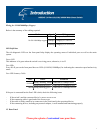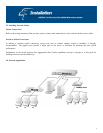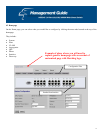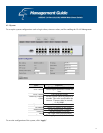
1.1 General Description
The device is a 24-port 10/100/1000Mbps Ethernet Web-Smart Switch.
Compared with traditional 10/100Mbps Ethernet, the switch delivers a dedicated Gigabit connection to every attached
client with no congestion issues. The gigabit ports also provide a larger pipe to the server or backbone connectivity for
boosting total system performance. The N-Way auto-negotiation (or auto-sense) function (refer to the chapter titled, “N-
way Process”) automatically adjusts the device for optimum operation. Duplex mode provides an easy way to integrate
10/100/1000Mbps networks without hassles. Each port delivers up to 2000Mbps throughput, and is able to operate in
either half or full-duplex modes. Under full-duplex mode, transmission and reception of frames occurs simultaneously
without causing collisions while doubling the network bandwidth.
The HGS24S is ideal for micro-segmenting large networks into smaller, connected subnets for improved performance,
enabling the bandwidth required by today’s networks for increasingly demanding applications of all kinds. Also, unlike
traditional “dumb” switches, the HGS24S features embedded advanced management capabilities: the device can be
managed via web-based UI or console port, thereby allowing the system manager to monitor and control the system
efficiently. “Store-and-Forward” architecture allows for low latency, eliminates error packets (including runt and CRC
error packets) and improves efficiency. The switch is plug-n-play without any software to configure and is fully
compliant with all the major network protocols. Moreover, the rich diagnostic LEDs on the front-panel give the user an
easy view of the operating status of individual ports or the entire system.
1.2 Gigabit Ethernet Technology
Gigabit Ethernet is an extension of the IEEE 802.3 standard, and can deliver up to a tenfold increase in throughput over
100-Mbps Fast Ethernet and up to a hundredfold increase over 10-Mbps Ethernet. It utilizes the same packet structure
and format, as well as support for CSMA/CD protocol, full duplex, flow control, and management objects. Because
Gigabit
Ethernet is compatible with all 10-Mbps and 100-Mbps Ethernet environments; it provides a seamless upgrade without
wasting existing investments in hardware, software, and/or trained personnel. With increased speed and more bandwidth,
Gigabit Ethernet is a great solution for reducing network bottlenecks that frequently develop as computers and their buses
get faster, and more users generate ever-greater traffic through the use of increasingly advanced applications. Upgrading
key components, such as backbones and servers, to Gigabit Ethernet can greatly improve network response times and
significantly increase the speed of traffic between your subnets.
Gigabit Ethernet supports video conferencing, complex imaging, and similar data-intensive applications. Likewise, since
data transfers occur at speeds up to 10 times greater than Fast Ethernet, servers outfitted with Gigabit Ethernet NIC’s
(Network Interface Cards) are able to perform 10 times the number of operations in the same amount of time.
5


















